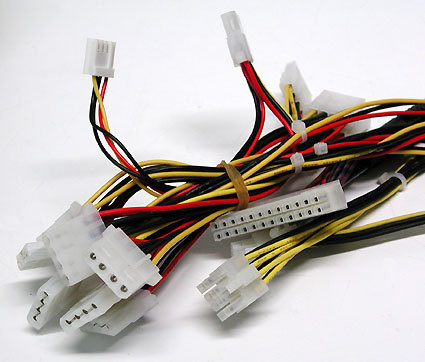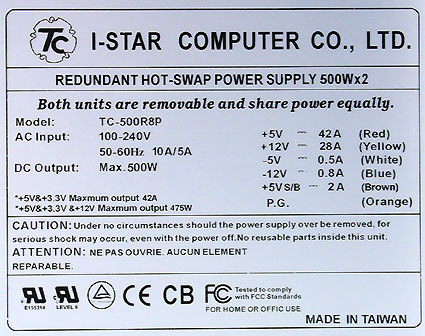Strong Showing: High-Performance Power Supply Units
Cables And Connectors
As is typical of workstation systems, the power supply features a four-pin P4 connector and an eight-pin variety for dual-CPU systems. The ATX/EPS plug comes in a 24-pin version, so an adapter is required for normal ATX motherboards. Besides a single floppy connector, the power supply has eleven 5.25" Molex connectors. Some graphics cards get their power via the smaller floppy connector, in which case you need an adapter if you also want to run a disk drive with the computer.
Another wire from the power supply goes to a status LED, which can be run up to the front of the computer system for monitoring current power supply status.
The cables are designed for the server and workstation segment.
Performance
Since the power supply is redundant, it had to go through our rigorous test run twice. First we let it run comfortably at half load on both units with their combined 500 W output; then we simulated failure of one unit so we could see what one of them alone was capable of.
Nameplate for the combined unit: it's all here
Each sub-unit also has its own nameplate
Get Tom's Hardware's best news and in-depth reviews, straight to your inbox.
As anticipated, there were no stability problems in redundant operation of any kind, and all the numbers were within the specifications.
The simulated failure of one input unit failed to stress the device. Even at full load, power remained constant to all areas without even a slight drop in voltage being observed. The TC-500R8P also was dutiful in reporting any problems.
Our endurance test running on only a single functioning power supply likewise failed to pose a problem for the I-Star power converter, as all voltages remained within specifications.
The redundant design naturally makes efficiency suffer. It registered 67% on half load, which is quite low; during "failure" of one supply input this figure rises to 68%. At very low load it looks much the same with an efficiency of only 55%, though it does go up to 60% when one input says "sayonara". It quickly became evident that this power supply is designed for running at full load when we repeated our measurement at maximum load. In redundant mode, the power supply reached its top value of exactly 72%, which fell to 70% with one unit down. Standby mode didn't look any better, as on low load the efficiency was a meager 17%, though it did register 41% at high load.
With server and workstation systems the prime focus is naturally on failure-proofing, and efficiency is only a secondary consideration.
The price of this power supply is not yet available.


